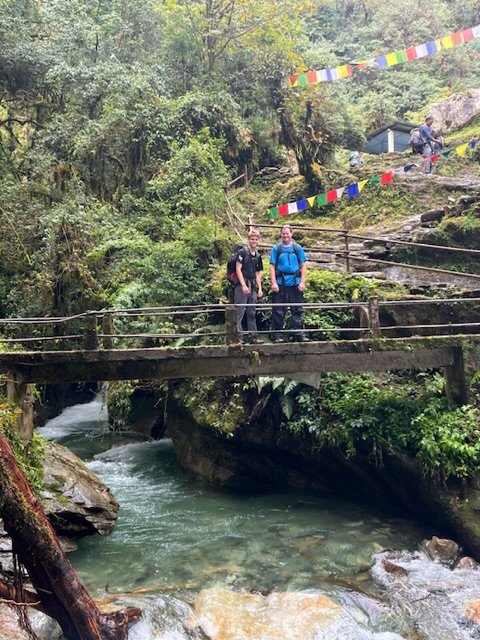Poon Hill Trek
Trekking in Nepal is a great way to get away from the hustle and bustle of the cities and into the remote mountain villages where life is slow and seemingly of a different time.
As soon as the rains let up we headed out. From Pokhara we followed the Seti river—milky white and flowing fast— toward the Annapurna, still hidden behind a veil of grey.
With heavy rains, mudslides and snow levels dropping, some routes were currently more challenging to access. We set off on the still doable Poon Hill trek, a 5 day hike within the Annapurna Conservation area.
The term tea house trekking sounds rather quaint, leisurely and, frankly, easy. It is none of the above. The trails are steep. The stone steps are slippery. Occasional mudslides require some scrambling. The streams have leaches. The uphill climbing feels like forever—heart pounding, lungs straining. The elevation gain apparent, especially to sea-level dwellers like us.
The guest-houses themselves are basic but comfortable. For those with high standards or who are particular about such things as reliable hot water, flushable toilets, electricity, questionable food safety standards, glitchy or no wifi, hard mattresses, single beds and reused blankets, then tea house trekking may not be your cup of tea, so to speak. But, if you are comfortable camping and are willing to roll with it, you’ll be fine. After a day of hiking we found the lodges to feel luxurious.
The trek started out rather leisurely through beautiful Nepali countryside—small farms and cottages of painted stone and brick. Shopkeepers stooped over, sweeping the cobbled walkway with long brooms of bundled dry grass, wrapped at the top with brightly colored string. Corrugated roofing patched together and held down with heavy stones. Namaste greetings at every turn.
We shared the trail with goats and cows, chickens and dogs. We stepped across streams, over mossy rocks and passed rushing waterfalls. Delicate flowers- himalayan aster, morning glory, marigolds, angels trumpet. We walked through forests containing every shade of green. We climbed ancient steps, winding their way up (and up) the mountainside, connecting village to village. Tattered prayer flags strung between trees and over streams. The trail continued to climb. And climb. And climb. 2 hours of stone steps straight up to the terraced hillside village of Ulleri. Exhausting. Brutal. Our legs melted out from under us at the first lodge we came to.
Our hosts welcomed us with hot massala tea, a warm fire to dry wet clothes, an indoor toilet, cold shower, and a 3-bed barebones bunk room with an amazing view. Pure Heaven. The days go on like this. Physical exhaustion balanced by extraordinary beauty, sprinkled with the kindness of people along the way, and the comfort of the most basic (but seemingly luxurious) accommodations.
We had an independent trekking permit, meaning we had no guide. These trails are well marked and well worn. We carried our own gear. Jon, with a gout-swollen and painful right foot was a trooper— hoofing it up and up, and down and down the whole way under the weight of his pack. More than once I heard him say “why didn’t we do this in our 20s?”
Each morning we set off, hiking through massive canopys of rhododendron and misty, twisty groves of trees with papery bark. reminded me of Madrona. It rained and it cleared. It was hot, then it was cold. The clouds were low. The mountains, playing peek-a-boo. And just when the our packs felt a little too heavy, backs wet with sweat, a bright blue roof would appear, maybe a painted welcome sign and a deck with a view. Hot tea. Cold juice. Catch our breath and then keep going.
We leapfrogged other travelers throughout the day. Some stopping here, some stopping there. New and Familiar faces each night. From England, France, Spain, Germany, Australia, and a couple from Texas. Some older, some younger. Most in groups with porters to carry their gear.
For the porters this is not an adventure. This is a livelihood. Step aside and let them pass. Heads down and bent over they trudge up the hills, up the stone steps…up and up…on and on…with some kind of inner drive and low gear power. 2-3 duffles each, loaded on their backs with a head strap, no hip-belt. Sneakers without tread. Quietly they walk. One foot in front of another. A gentle nod. They pass by. Slow and steady. Always the first to arrive.
Everything must come up these trails. Food, and fuel, building materials, clothes and furniture…We passed a man making his way up the mountain with a refrigerator strapped to his back. This is how it is to live here. This is what you do…
We are passing through. We are tired and sore with no grounds to complain. What we are offered we receive with gratitude.
At night the walls are paper thin and the voices are loud. The porters are young. They’ve earned a drink. Up late with the moon, then up again with dawn. At Tadepani we woke to their whoops and wows and they broke into Nepali song. The clouds had parted, the peaks were gleaming in the sunrise glow.
As many times as they have seen this view— when the Annapurnas and Machapuchare are revealed it is enchanting. Sublime. It’s hard to look away. So magestically close and yet still so far. It is pure awe. Takes your breath away.
Then it’s back to business. Milk tea and muesli. Instant coffee and apples chopped with an onion knife. Pack up and set off early, descending the mountain in a 10 mile final push downhill. Traversing terraces of cabbage and rice. Stepping aside for ponys hauling rocks and fuel.
With sore knees and burning calves, we finally set foot on a road, just above the river. A shop keeper informs us we are in good luck. The bus will be here soon.


































































































